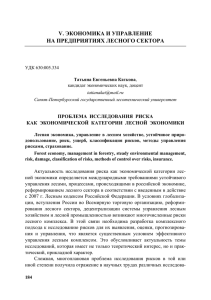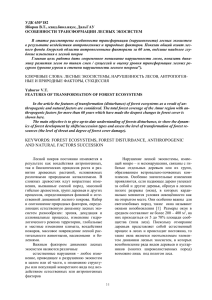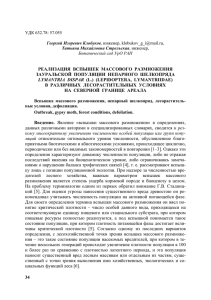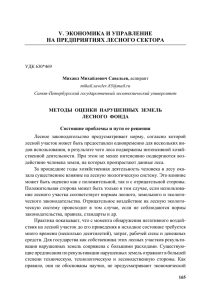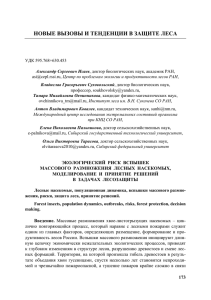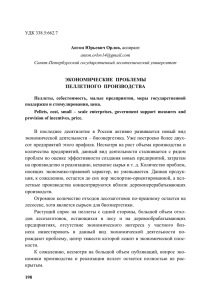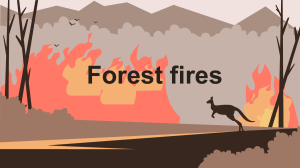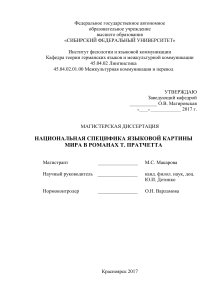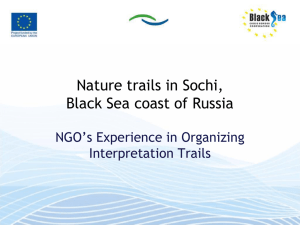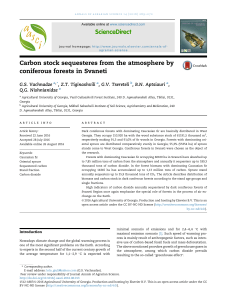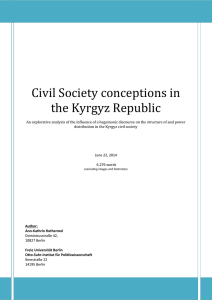Алмазбек Анарбекович Орозумбеков, кандидат биологически
реклама
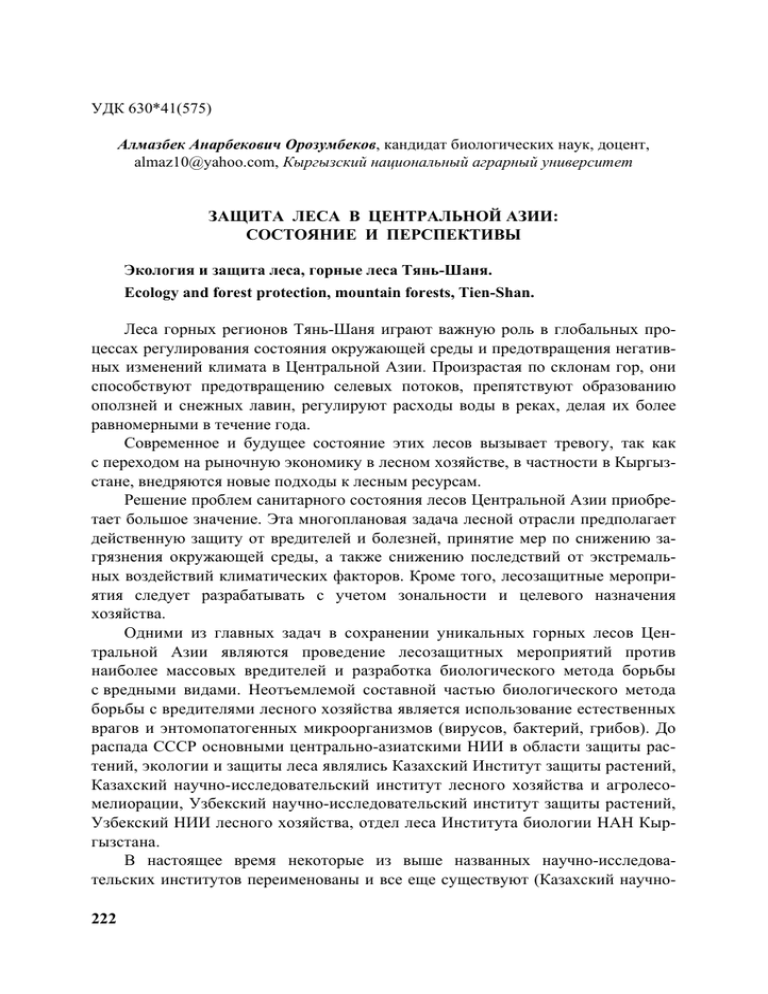
630*41(575) Ⱥɥɦɚɡɛɟɤ Ⱥɧɚɪɛɟɤɨɜɢɱ Ɉɪɨɡɭɦɛɟɤɨɜ, , , [email protected], Ʉɵɪɝɵɡɫɤɢɣ ɧɚɰɢɨɧɚɥɶɧɵɣ ɚɝɪɚɪɧɵɣ ɭɧɢɜɟɪɫɢɬɟɬ ɁȺɓɂɌȺ ɅȿɋȺ ȼ ɐȿɇɌɊȺɅɖɇɈɃ ȺɁɂɂ: ɋɈɋɌɈəɇɂȿ ɂ ɉȿɊɋɉȿɄɌɂȼɕ ɗɤɨɥɨɝɢɹ ɢ ɡɚɳɢɬɚ ɥɟɫɚ, ɝɨɪɧɵɟ ɥɟɫɚ Ɍɹɧɶ-ɒɚɧɹ. Ecology and forest protection, mountain forests, Tien-Shan. - . , , , , . , , , - . . , - , . , . - . ( , , ). - , , - , , , . ( 222 - , , - , ). . , , . , - , , , . [1]. [2, 3]. Apocheima cinerarius - Ersch. [4]. , [5] . ( ) . Acantholyda posticalis Mats., » [6]. - , « i » - « - 2006 . 17 361 . Hyphantria cunea Drury ( ), . . 2003 . . 28 - - - [7]. , , , . , Bacillus thuringiensis subsp. kurstaki, Z-52, , - . 223 [7]. - 1984–1986 Lymantria dispar (L.). . 20 . . 12 . 1996–1998 . - [8]. - . - , , . - , - . . (+) . . (1982–1985 .) [9]. , 2006–2010 ., 27.09.2006 . № 693. - 2010 2015 . 2010 . , . 1 123 045,2 , 2008 - , – 5,62 % . , , , , - - , . L. dispar, . Erannis defoliaria Cl., Malacosoma parallela Stgr., Sphaerocanium prunastri Fonsc., Caliroa limancina L. [10, 11]. , . 224 – Monochamus galloprovincialis Ol. , Inonotus hispidus (Bull.) P. Karst Polyporus squamosus (Huds.) Fr. 2011 . . . pygmaea Klug , amylovora (Burrill) Winslow et al. Profenusa Erwinia , . 1964 . 1954 . 1700 [12]. 40 . , 1970 ., 1980. 1990- . – 52 . , . . 1970. 1963– [12, 13]. - ( ) [14, 15]. . - . - . 1980- . . . ( . , ), , , L. dispar . 1983 . – ( ) . . . . ( . - . ) ( ) , ( – 1983 . ) 1,2 [16]. ( ) 1995 . , – ( ( ) 1984–1986 ). . 225 53,7 81,1 % , [15]. - , . [16]. - . . , - . 1990- . . , - , . . ( , , , ) - ) - [13, 16–18]. ( . . ( ) , , B. thuringiensis (H5ab , H3abc) - [16]. , ( . [19, 20]. - ) , 2001–2008 . - , (+) 226 . 500 . . .) (700–2000 . [20]. - - , [21]. : (2001–2005 .), . - (2004–2005 .), . - . (2007 .), (2007 .), . - (2008 .). , , , . . - , [22]. . , - , . , - . , . Ȼɢɛɥɢɨɝɪɚɮɢɱɟɫɤɢɣ ɫɩɢɫɨɤ 1. Ɍɟɥɟɝɢɧɚ, Ɉ.ɋ. [ ]/ . . // : . №4 , , 2004. – . 118–121. 2. Ƚɧɢɧɟɧɤɨ, ɘ.ɂ. . – [ , . . , . . // ]/ . . , . . . – 1999. – № 2. – . 121–122. 227 3. ɋɚɝɢɬɨɜ, Ⱥ.Ɉ. - [ 90- ]/ (Acantholyda posticalis Mats.) , . . // . .. ., . , 7– 9 2004. – . 74–77. Apocheima cinerarius Ersch. – [ ]: . .… . . - . . : . . 4. ɉɥɚɤɫɢɧɚ, Ⱥ.ɋ. / . . .– , 1952. – 10 . 5. ɋɭɥɬɚɧɨɜ, Ɋ.Ⱥ. – [ ]/ . . // : . . .– . 156. – ., 1984. – . 81–86. 6. Ɇɭɯɚɦɚɞɢɟɜ, ɇ.ɋ. (Acantholyda posticalis Mats.) [ ]: . .… . . / . . .– , 2007. – 25 . 7. Ʉɨɩɠɚɫɚɪɨɜ, Ȼ.Ʉ. (Hyphantria cunea Drury) [ ]: . .… . . / . . .– , 2007. – 23 . 8. Ɍɟɥɟɝɢɧɚ, Ɉ.ɋ. [ ]/ . . , . . // : XXI : . . . . V . . . , 20–25 2011 . – : , 2011. – . 82–84. 9. Ⱥɛɚɟɜ, Ɋ.ɂ. [ ]/ . . , . . // . . .– , 1984. – C. 2. 10. Ɋɨɦɚɧɟɧɤɨ, Ʉ.ȿ. [ ]/ . . .– : , 1984. – 155 . 11. Ɍɨɤɬɨɪɚɥɢɟɜ, Ȼ.Ⱥ. [ ]: . . ... . / . . . – .: , 1993. – 45 . 12. ɉɨɧɨɦɚɪɟɜ, ȼ.ɂ. : , , [ ]/ . . , . . , . . , . . .– : , 2008. – 124 . 13. Orozumbekov, A.A. The Gypsy moth (Lepidoptera: Lymantriidae) in Central Asia [Text] / A.A. Orozumbekov, A.M. Liebhold, V.I. Ponomarev, P.C. Tobin // American Entomologist. – 2009. – Vol. 55, no. 4. – P. 258–264. 14. ȼɨɪɨɧɰɨɜ, Ⱥ.ɂ. [ ]/ . . . – .: . - , 1984. – 260 . 15. Ƚɧɢɧɟɧɤɨ ɘ.ɂ. [ ]/ . . // : . . . , 5–10 .– , 1999. – . 60–63. 16. Ɍɨɤɬɨɪɚɥɢɟɜ, Ȼ.Ⱥ. [ ]/ . . , . . , . . . – .: , 2010. – C. 81–89. 17. Ⱦɨɨɥɨɬɤɟɥɶɞɢɟɜɚ, Ɍ. [ ]/ . .– , 2001. – 160 . 228 18. Ɉɪɨɡɭɦɛɟɤɨɜ, Ⱥ.Ⱥ. [ ]: . .… . . / .– , 2001. – 23 . 19. Orozumbekov, A.A. Population ecology of gypsy moth in Kyrgyzstan [Text] / A.A. Orozumbekov, V.I. Ponomarev, A. Mamytov, E.M. Andreeva and .A. Liebhold // XIV USDA Interagency Research Forum on the Gypsy Moth & Other Invasive Species, Annapolis, Maryland, USA, January 11–14, 2003. – P. 149–150. 20. ɉɨɧɨɦɚɪɟɜ, ȼ.ɂ. [ ] / . . , . . , . . , . . , . . // XXI. – 2007. – № 4–6. – . 41–43. 21. Ⱥɲɢɦɨɜ, Ʉ.ɋ. , [ ]: . .… . . / . . . – ., 1989. – 24 . 22. Ɇɨɡɨɥɟɜɫɤɚɹ, ȿ.Ƚ. [ ]/ . . , . . , . . // : : . . XII .– .: , 2003. – . 3–13. . . - . - , , , . . , , - . , , , - . ( , , - . ) , - . . , , , , . 229 . , . *** Forests in mountain regions of Tien-Shan are of great ecological importance in the global processes of environmental management and prevention of adverse climate change in Central Asia. Current and future state of these forests is alarming, since the transition to a market economy in forestry, particularly in Kyrgyzstan, is introducing new approaches to forest resources management. Decision of problem concerning forests in Central Asia is of great importance. This complex problem in the forestry sector involves effective protection against pests and diseases of natural and artificial forest plantations in the mountainous areas of Kazakhstan, Uzbekistan and Kyrgyzstan. Research experts in the field of forest protection are aimed to create and support effective methods of integrated protection against forest pests in Central Asia, including agrotechnical, mechanical, chemical and biological methods. Considerable effort has focused on development of microbiological methods against pests in Central Asia. This raises the need to find and obtain highly virulent strains of entomopathogenic microorganisms (bacteria, viruses, fungi and protozoa) with high insecticidal properties and to create on their basis of local biological preparations against forest pests. The issue of using the pheromone traps (a milk carton boxes) for monitoring and forecasting of the gypsy moth’s and other pests quantity in the mountainous regions of Central Asia is one of great practical importance. However for all difficulties the forest protection in Central Asia is not inferior to its widest position and, although slowly, but steadily and purposefully develops and expands its capabilities. This is largely due to the close relationship of practical forest protection and science. Forest protection specialists need to be supported by legislative and administrative bodies, primarily in the allocation of funds for maintenance of forest pest monitoring and implementation of forest protection issues. 230
